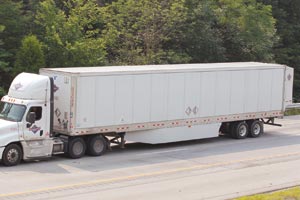Trailer Makers Say GHG Plan Exceeds EPA’s Legal Authority

Trailer makers are troubled by the Phase 2 proposal on greenhouse-gas emissions, with some asserting the agencies involved exceeded their regulatory authority and others arguing the mandates are overly aggressive and based on faulty assumptions.
The manufacturers filed comments with the Environmental Protection Agency and the National Highway Traffic Safety Administration in response to the agencies’ proposed rule covering heavy- and medium-duty trucks released in June.
Phase 1 took effect in January 2014 and covered trucks and engines, but not trailers. Trailers have long been regulated with respect to size and safety, but this is the government’s first crack at an emissions rule with a trailer section.
“A trailer is not powered for self-transportation and does not directly produce [carbon dioxide]; therefore, is not under the authority of EPA with regard to the area of focus,” said Gary Fenton, vice president of engineering for Stoughton Trailers. “Do not regulate non-CO2 producing transportation equipment.”
A Utility Trailer Manufacturing Co. executive said the company appreciates the goal of reducing emissions. “Unfortunately, by extending its proposed rule to semi-trailers, EPA has adopted an unprecedented interpretation of its authority that exceeds its congressional authorization,” said Jeffrey Bennett, a Utility vice president and engineer.
“The agencies have based their analysis on assumptions that are completely untethered from the real world, resulting in proposed regulations that will yield minimal, if any, net greenhouse-gas reduction while imposing crippling administrative burdens on the semi-trailer industry,” he added.
The Truck Trailer Manufacturers Association also argued that EPA’s proposal “lacks legal authority, has significant safety impacts and is overly broad and complex in light of the more functional existing voluntary systems,” said John Freiler, TTMA’s engineering manager.
Wabash National Corp., North America’s largest trailer maker, is worried about mandates for
low-rolling-resistance tires and automatic tire-inflation systems.
“We are concerned with LRR tire and ATIS suppliers’ ability to meet increased demand and support their products in the field, particularly if suppliers are rushing to provide parts necessary to ramp up to 100% compliance quickly,” said James Scarcelli, a Wabash vice president.
“Lack of ATIS maintenance is a safety concern, as is the potential for lesser-quality systems to flood the market as a result of rapidly increasing demand for ATIS,” he added.
Wabash also said EPA and NHTSA need to consider what other regulators are doing. The four obvious examples, the company said, are NHTSA’s work on underride guards, the proposal to increase the length of pup trailers to 33 feet, weight exemptions for aerodynamic devices and harmonizing federal rules with those from the California Air Resources Board.
Great Dane Trailers also has concerns.
“We have customers who have stated to us that low-rolling-resistance tires and/or automatic tire inflation systems do not meet their expectations and thus they do not specify those components. Our sales records support that fact,” said Charles Fetz, a Great Dane vice president.
The company was typical of other manufacturers in its discussion of warranties. Trailer makers, Fetz said, don’t offer warranties on an entire trailer. Much of what they do is to pass through the warranties from their suppliers, including tire makers, to their customers.
One of those tire makers said his company could not guarantee the improvement sought by EPA and NHTSA on rolling resistance.
“The development of future-generation LRR tires with minimal or no compromise on other important performance characteristics [such as traction and durability] will require significant research and development, and industrialization investments,” said John Emerson, director of industry standards and government regulations for Michelin North America.
“Such additional costs are not properly reflected in the current regulatory impact analysis [for the rule],” Emerson said.
Thermo King, the manufacturer of trailer refrigeration units, warned about closing the gap between tractors and trailers.
While such a narrowing does improve aerodynamic performance, “this would block the required airflow to the heat exchanger surfaces contained within the TRU, which is necessary to provide adequate refrigeration to the trailer’s contents efficiently.”
Trailer makers also opposed the rule’s Alternative 4, which would accelerate 2027 standards to 2024. They endorsed the idea of a midcourse review to see if those 2027 standards are feasible.
Utility’s Bennett recommended that the government instead continue with EPA’s voluntary SmartWay program. He said the agencies overestimate significantly the time that tractor-trailers spend driving along highways at high speed and the number of trucks that do this.
Bennett said the poor federal estimation means the proposal vastly overstates the value of aerodynamic equipment in reducing CO2 emissions.

